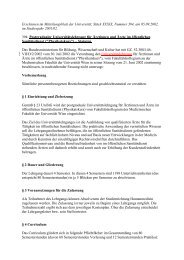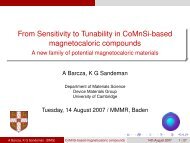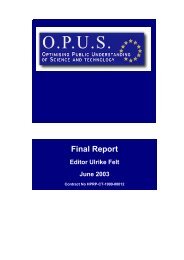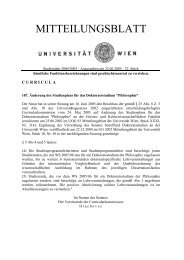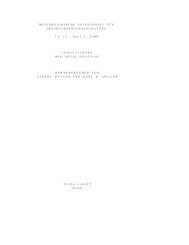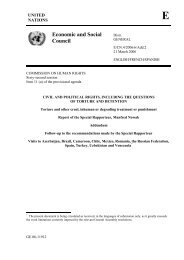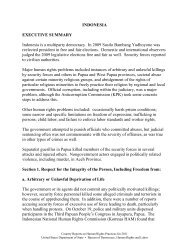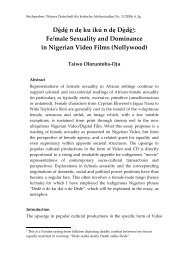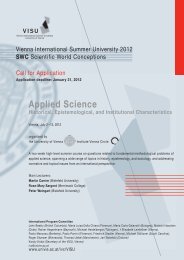(Stand: 25. Juli 2007) ANDERSON, Michael Alan ... - Universität Wien
(Stand: 25. Juli 2007) ANDERSON, Michael Alan ... - Universität Wien
(Stand: 25. Juli 2007) ANDERSON, Michael Alan ... - Universität Wien
You also want an ePaper? Increase the reach of your titles
YUMPU automatically turns print PDFs into web optimized ePapers that Google loves.
MEDIEVAL & RENAISSANCE MUSIC CONFERENCE <strong>2007</strong> – WIEN, 7.-11. AUGUST ABSTRACTS<br />
Weise nur mehr ein relativ geringer Teil der ursprünglichen Handschriften erhalten<br />
geblieben ist, werden diese Fragmente heute als die ältesten musikalischen Quellen der<br />
Stadt <strong>Wien</strong> angesehen.<br />
Gerade hinsichtlich ihrer über die Hausmusikgeschichte des Schottenstiftes <strong>Wien</strong><br />
hinausgehenden Bedeutung und ihrer klaren Abgrenzung zu anderen benachbarten Klöstern<br />
der damaligen Zeit, ist es naheliegend, sich näher mit diesen Fragmenten auseinanderzusetzen.<br />
Ein mittlerweile abgeschlossenes Forschungsprojekt ging in den letzten Jahren<br />
vor allem der Frage nach, woher die musikalische Tradition der sogenannten „Schottenmönche“,<br />
die alle in Irland selbst geboren sein mussten, kam: direkt aus Irland oder<br />
von einem anderen Ort des europäischen Kontinentes? Auch wenn die direkten Vergleichshandschriften<br />
in anderen Bibliotheken nur mehr spärlich erhalten geblieben sind,<br />
können doch wesentliche Fragen auch heute noch beantwortet werden. In diesem Sinn<br />
wird im Rahmen dieses Vortrages versucht, die in den vergangenen Jahren erzielten Forschungsergebnisse<br />
und deren Auswirkung auf die mittelalterliche Musikgeschichte <strong>Wien</strong>s<br />
zusammenzufassen.<br />
� �<br />
DE FORD, Ruth (Hunter College and Graduate Center, CUNY)<br />
Who devised the proportional notation in Isaac’s Choralis Constantinus?<br />
Freitag/Friday, 10.8., 10.15 Uhr, MuWi, HS 1<br />
Isaac’s Choralis Constantinus has been renowned as a source of complex proportional notation<br />
since the 1530s. Sixteenth-century theorists beginning with Sebald Heyden drew examples<br />
from it even before it was published, and it has played a prominent role in studies<br />
of mensural notation ever since. Although the work has been interpreted as a key to<br />
Isaac’s mensural usage, much of its unusual notation may be the work of Heyden, not<br />
Isaac. Many of its proportion signs appear in no other works of Isaac, and some exist nowhere<br />
else outside of theoretical treatises. The unconventional signs are concentrated in a<br />
handful of numbers that make up only about one percent of the collection. They apply to<br />
commonplace rhythms that were normally notated in much simpler ways. As a liturgical<br />
collection, Choralis Constantinus is not the type of work a composer would normally choose<br />
to display notational complexities of a purely theoretical nature, but Heyden would have<br />
had both the opportunity and a plausible motive to edit Isaac’s notation for his own purposes.<br />
He was the leading authority on music in Nuremberg, where the music of Choralis<br />
Constantinus was collected and edited for publication two decades after Isaac’s death. The<br />
second edition of his De arte canendi, the earliest surviving source for two of the complex<br />
numbers, appeared in 1537, the year in which Johannes Ott announced the forthcoming<br />
publication of Isaac’s work. (Various complications delayed the appearance of the publication<br />
until 1550-55.) Heyden generated many of his examples by altering the notation of<br />
existing works. If he subjected the Isaac examples to this treatment, he would surely have<br />
encouraged Ott to adopt his revised notation in the print. The question of who devised the<br />
unusual proportions in Choralis Constantinus has implications both for the broader interpretation<br />
of Isaac’s notation and for the relationships among manuscript sources of the<br />
collection, including Berlin, Deutsche Staatsbibliothek, Ms. 40024, and Vienna, Österreichische<br />
Nationalbibliothek, Ms. 18745.<br />
- 25 -




